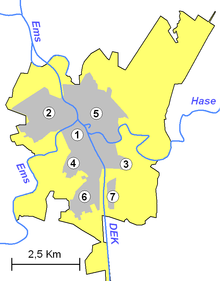Meppen-Esterfeld settlement
The settlement of Meppen-Esterfeld in Emsland was discovered in 1975 under a 0.6–1 m thick sand drift, exposed over an area of 20,000 m² and dated to the middle to late pre-Roman Iron Age based on the ceramics .
In Meppen - Esterfeld in the Emsland in Lower Saxony , the remains of three groups of farmsteads , each with main and auxiliary buildings and fences, were found. The transversely open, two-aisled ridge post structures of the main building had four central posts. One was 18 m long and about 7 m wide. The clay-lined hearths, the east-west oriented buildings, were in the west. The discoloration of the threshold in the east could come from cattle sheds . The outbuildings were storehouses about four by three meters, erected on posts and presumably containing supplies and seeds . Fences on the edge are remnants of an enclosure that may enclose the entire settlement .
See also
literature
- Dieter Zoller: A settlement from the pre-Roman Iron Age near Meppen, Kr. Emsland . News from Lower Saxony's Prehistory 46, 1977, pp. 233–239
- Hans-Jürgen Häßler (Ed.): Prehistory and early history in Lower Saxony . Theiss, Stuttgart 1991, ISBN 3-8062-0495-0 , p. 480
